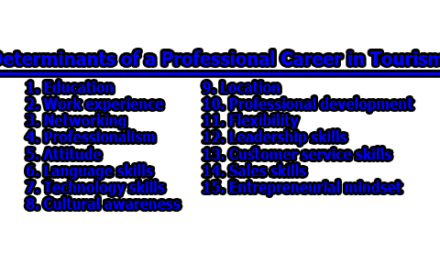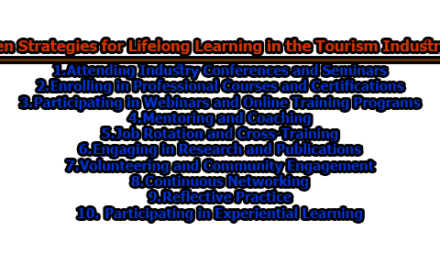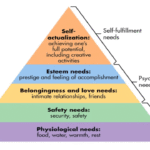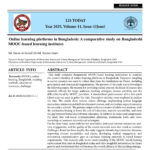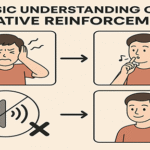15 Strategies to Inform Your Community about Your New Tour and Travel Company:
Launching a new tour and travel company is an exciting endeavor, but informing the community about its existence is a crucial step toward success. As the communications officer for your company, you have a vital role in spreading the word and generating interest among potential customers in your local area. To achieve this, you must employ a comprehensive and multifaceted marketing strategy that effectively informs the community about your travel services. In this article, we’ll explore 15 strategies to inform your community about your new tour and travel company.
Strategy 1: Create a Professional Website:
A company’s website serves as the virtual storefront and often the first point of contact for potential customers. It’s crucial to have a well-designed, informative, and user-friendly website to inform the community about your new tour and travel company. Here’s how to go about it:
- Domain and Hosting: Choose a memorable domain name that reflects your business and secure reliable hosting for your website. Make sure the domain is easy to remember and closely related to your company’s name or the travel industry.
- Website Design: Invest in professional web design to create an appealing, modern, and responsive website. Ensure that the website loads quickly, is easy to navigate, and looks good on both desktop and mobile devices. A clean and visually attractive layout with high-quality images is essential, as it will entice visitors to explore further.
- Informative Content: Include detailed information about your tour and travel services, destinations you cover, pricing, itineraries, and contact details. Provide engaging content that educates visitors about the destinations and experiences you offer. Use high-resolution images and videos to showcase your offerings.
- Clear Navigation: Design an intuitive menu and navigation structure. Make it easy for visitors to find the information they need. Consider incorporating a booking system or inquiry form for immediate customer engagement.
- Search Engine Optimization (SEO): Optimize your website for search engines by including relevant keywords and phrases. This helps your site rank higher in search results, making it more discoverable to potential customers. Ensure meta tags, alt text, and header tags are appropriately used to boost SEO.
- Customer Testimonials: Share reviews and testimonials from satisfied customers to build trust and credibility. Authentic feedback from previous travelers can be a powerful persuader.
- Contact Information: Make your contact information easily accessible, including phone numbers, email addresses, and physical office locations. You can also include a live chat feature to assist visitors in real-time.
- Blog Section: Maintain a blog section with informative articles related to travel, destinations, tips, and industry trends. Regularly update this section to show that your company is well-informed and actively engaged in the travel community.
- Social Media Integration: Link your social media profiles to the website and include sharing buttons on blog posts and other content. This allows visitors to easily share your content with their networks.
- Newsletter Sign-Up: Encourage visitors to subscribe to your newsletter. This builds a database of potential customers who are interested in your services and allows you to send them updates, promotions, and travel tips directly.
A professional website is the cornerstone of your online presence. It not only informs the community about your company but also establishes your credibility and serves as a hub for various online marketing efforts, such as SEO, content marketing, and email campaigns.
Strategy 2: Social Media Marketing:
Social media is a powerful tool for promoting your new tour and travel company, as it allows you to engage with a wide audience and build a community of travel enthusiasts. Here’s how to effectively use social media for your company:
- Platform Selection: Start by identifying which social media platforms are most relevant to your target audience. Platforms like Facebook, Instagram, Twitter, and LinkedIn are common choices for travel companies. Each platform has its own strengths, so consider where your potential customers spend their time.
- Profile Optimization: Create professional and appealing profiles on each platform. Use high-resolution, eye-catching images for profile and cover photos, and ensure your company’s branding is consistent across all social media channels.
- Content Strategy: Develop a content plan that includes a mix of posts, including visually appealing travel photos, videos, informative articles, and engaging stories. Share content that highlights destinations, travel tips, customer testimonials, and promotions.
- Consistent Posting: Regularly update your social media profiles with fresh content. Create a posting schedule that aligns with your audience’s online activity. You can use social media management tools to plan and automate posts.
- Engagement: Respond to comments and messages promptly to foster a sense of community and engagement. Encourage discussions and ask questions to get your followers involved. Also, engage with related travel pages and influencers to expand your reach.
- Hashtags: Use relevant and trending hashtags to increase the discoverability of your posts. Include both industry-specific and location-specific hashtags to reach a broader audience.
- User-Generated Content: Encourage customers to share their travel experiences with your company on social media. Share their posts, tag them, and express your appreciation. User-generated content provides social proof and authenticity.
- Promotions and Contests: Run occasional social media contests or promotions to engage your audience and encourage them to share your content. For example, you can run a photo contest with travel-themed prizes.
- Paid Advertising: Consider investing in paid social media advertising to reach a wider, targeted audience. Platforms like Facebook and Instagram offer detailed targeting options to show your ads to people interested in travel.
- Analytics and Insights: Regularly review the analytics and insights provided by each social media platform. This data can help you understand what content is most popular and how your audience is engaging with your posts.
- Community Building: Cultivate a sense of community by creating groups or forums where your customers and followers can discuss travel-related topics, share experiences, and seek advice.
Social media marketing allows you to showcase your company’s personality and build a loyal following. It’s a dynamic and interactive platform that, when used effectively, can help inform the community about your tour and travel services and encourage them to follow, engage, and eventually book trips with your company.
Strategy 3: Email Marketing:
Email marketing is a cost-effective and direct way to reach out to potential customers, keep them informed about your tour and travel company, and nurture relationships over time. Here’s how to effectively use email marketing:
- Build an Email List: Start by building a permission-based email list. Encourage website visitors, social media followers, and previous customers to subscribe to your newsletter or email updates. Offer incentives like exclusive travel tips or discounts for subscribers.
- Segment Your List: Segment your email list to send targeted and relevant content to different groups of subscribers. For example, you can segment by location, travel interests, or previous interactions with your company.
- Personalization: Personalize your email content by addressing recipients by name and tailoring the content to their interests and preferences. Personalization can significantly increase engagement and conversion rates.
- Engaging Subject Lines: Craft compelling and relevant subject lines to entice recipients to open your emails. Avoid spammy or misleading subject lines, as they can damage your sender reputation.
- Valuable Content: Provide value in your emails. This can include travel guides, insider tips, destination highlights, and special offers. Your content should inform, educate, and inspire readers.
- Visual Appeal: Use eye-catching visuals in your emails, such as high-quality images and videos. Visual content can make your emails more engaging and memorable.
- Mobile Optimization: Ensure that your email templates are mobile-responsive, as many people check their emails on smartphones and tablets. A mobile-friendly design is crucial for a positive user experience.
- Clear Call to Action (CTA): Include a clear and concise CTA in your emails, whether it’s to book a trip, download a travel guide, or follow your social media accounts. Make it easy for recipients to take the desired action.
- A/B Testing: Experiment with A/B testing to optimize your email campaigns. Test different subject lines, content, and CTAs to determine what resonates best with your audience.
- Automation: Use email marketing automation tools to send targeted messages at the right time. For example, you can set up automated welcome emails, birthday greetings, or post-trip follow-ups.
- Monitor Analytics: Keep a close eye on email campaign analytics, such as open rates, click-through rates, and conversion rates. Use this data to refine your email marketing strategy and improve future campaigns.
- Compliance: Ensure that your email marketing practices comply with regulations like GDPR and CAN-SPAM. Include an option for recipients to unsubscribe, and respect their preferences.
Email marketing can be a powerful tool to nurture leads, keep your community informed about your travel company’s offerings, and drive repeat business. When done well, it can foster a sense of belonging and loyalty among your subscribers, leading to increased bookings and referrals.
Strategy 4: Local SEO (Search Engine Optimization):
Local SEO is essential for ensuring that your tour and travel company is visible to your local community when they search for travel services online. It’s a critical component of informing your community about your company’s existence. Here’s how to effectively use local SEO:
- Google My Business (GMB): Claim and optimize your Google My Business listing. Ensure that all the information about your company is accurate, including your name, address, phone number, website, and hours of operation. Add high-quality images of your travel destinations and services.
- Local Keyword Optimization: Identify and incorporate local keywords into your website content. This might include keywords like “tour company in [your city]” or “travel agency near me.” Use these keywords naturally within your website’s text.
- Citations: Ensure that your company’s name, address, and phone number (NAP) are consistent across all online platforms, including your website, GMB, social media profiles, and local directories. Inaccurate or inconsistent NAP information can harm your local SEO efforts.
- Online Reviews: Encourage customers to leave reviews on your GMB listing and other review platforms like Yelp or TripAdvisor. Positive reviews can boost your visibility and credibility in local search results.
- Local Link Building: Build relationships with local businesses and organizations to earn backlinks from their websites. Local backlinks can help improve your website’s authority in local search results.
- Location Pages: If your company serves multiple locations, create dedicated location pages on your website. Each page should have unique content and include details about the services and attractions specific to that location.
- Mobile Optimization: Ensure that your website is mobile-friendly, as local searches often happen on mobile devices. Google prioritizes mobile-friendly websites in search results.
- Schema Markup: Implement schema markup on your website to provide search engines with structured data about your business, such as your services, reviews, and location.
- Content Localization: Tailor your content to reflect the local culture and interests of your community. For instance, write blog posts about local events, tourist attractions, or travel tips specific to your area.
- Monitor Analytics: Regularly review your website’s analytics to track the performance of your local SEO efforts. Pay attention to key metrics like organic search traffic, user engagement, and conversion rates.
- Google Maps Optimization: Optimize your presence on Google Maps by ensuring your location is accurate, responding to user questions and reviews, and using relevant categories and keywords.
Local SEO is crucial for making your tour and travel company discoverable to potential customers in your community. By optimizing your online presence for local search, you increase the chances of people finding your company when they search for travel services in your area. This can lead to more website traffic, inquiries, and bookings from local residents and visitors.
Strategy 5: Content Marketing:
Content marketing is a powerful strategy to inform the community about your new tour and travel company. It involves creating and sharing valuable, relevant, and consistent content to attract and engage your target audience. Here’s how to effectively use content marketing:
- Start a Blog: Launch a blog on your company’s website. Regularly publish high-quality articles related to travel destinations, travel tips, itineraries, and other relevant topics. These articles should provide valuable information and insights to your readers.
- Content Calendar: Create a content calendar to plan and schedule your blog posts and other content. Consistency is key, so establish a regular posting schedule that your audience can rely on.
- Keyword Research: Conduct keyword research to identify relevant search terms and phrases in your niche. Incorporate these keywords naturally into your blog posts to improve your website’s search engine visibility.
- Guest Blogging: Consider guest blogging on reputable travel websites and platforms. This can help you reach new audiences and establish your company as an authority in the travel industry.
- Visual Content: Utilize high-quality images, videos, and infographics in your content. Visual content is engaging and can help convey the beauty and experiences of the destinations you offer.
- Shareable Content: Create content that is shareable on social media. Travel inspires people, so content that showcases stunning destinations or offers unique travel insights can go viral and reach a wider audience.
- Educational Content: Offer travel advice and guides. Address common traveler concerns and questions, such as packing tips, budget travel strategies, or travel safety advice.
- User-Generated Content: Encourage your customers to share their travel experiences with your company. Share their photos, videos, and stories on your website and social media. User-generated content adds authenticity and builds trust.
- Email Newsletters: Promote your blog content through email marketing. Send out newsletters featuring your latest blog posts, and encourage your subscribers to visit your website for more information.
- Engagement: Engage with your audience in the comments section of your blog and on social media. Answer questions, acknowledge feedback, and create a sense of community around your content.
- Measure and Analyze: Use website analytics to track the performance of your content. Identify which articles are the most popular, which topics generate the most engagement, and which posts lead to conversions.
- Repurpose Content: Repurpose your best-performing content into different formats. For example, turn a popular blog post into a video or a series of social media posts.
Content marketing is a long-term strategy that can inform and educate your community about your travel company. It positions your company as an expert in the field, attracts organic traffic to your website, and encourages visitors to explore your services and book their next travel adventure with you.
Strategy 6: Partnerships and Affiliations:
Building partnerships and affiliations with other businesses, particularly those related to the travel and tourism industry, can be an effective way to inform the community about your new tour and travel company. Here’s how to do it effectively:
- Identify Potential Partners: Look for local businesses, such as hotels, restaurants, transportation companies, or event venues, that align with your travel services. These businesses can provide complementary services to your customers.
- Establish Collaborative Agreements: Approach potential partners with proposals for mutually beneficial collaboration. For instance, you could work with a local hotel to create exclusive travel packages for their guests.
- Cross-Promotion: Collaborate on marketing efforts. Share each other’s content, events, or promotions on social media, newsletters, and websites. This cross-promotion extends your reach to each partner’s customer base.
- Joint Promotions: Create joint marketing campaigns or promotions. For example, offer discounts or special packages when customers book services from both your company and your partner’s business.
- Referral Programs: Develop referral programs with your partners. When a customer books services with one partner, offer incentives for them to refer friends and family to your services. This can be a win-win for both companies.
- Affiliate Marketing: Consider setting up an affiliate program where other businesses or individuals can earn a commission for referring customers to your travel services.
- Local Events: Participate in local events and fairs together with your partners. This allows you to network, showcase your services, and strengthen your relationships within the community.
- Customer Testimonials: Encourage satisfied customers to provide testimonials that mention their positive experiences with both your company and your partner’s services. Display these on your website and marketing materials.
- Community Involvement: Collaborate with partners on community involvement activities, such as sponsoring local events or participating in charitable initiatives. This not only promotes your businesses but also demonstrates your commitment to the community.
- Networking: Attend industry-specific events, such as travel expos or tourism association meetings, to meet potential partners and expand your network. Building relationships in the travel industry can open up new partnership opportunities.
- Legal Agreements: When establishing partnerships and affiliations, be sure to create clear legal agreements that outline the terms and responsibilities of each party. This ensures that both parties are on the same page and protects the interests of all involved.
Building partnerships and affiliations can significantly expand your reach and credibility within the community. By working with other local businesses and sharing resources, you can tap into their existing customer base and increase your brand visibility in a cost-effective manner. It’s a valuable strategy for informing the community about your travel company’s offerings and building trust with potential customers.
Strategy 7: Participation in Local Events:
Participating in local events and community activities can be a highly effective way to inform the community about your new tour and travel company. Here’s how to do it effectively:
- Research Local Events: Identify local events, fairs, festivals, and trade shows related to travel, tourism, or your target customer base. Additionally, consider participating in general community events where you can showcase your company.
- Set Up a Booth: Reserve a booth or exhibit space at these events. Design an attractive booth that reflects your company’s brand and services. Use banners, brochures, and promotional materials to draw visitors to your booth.
- Interactive Activities: Plan interactive activities or demonstrations at your booth. For example, you could have a virtual reality station that allows attendees to experience travel destinations, or provide hands-on demonstrations of travel gear or accessories.
- Engage Attendees: Train your staff to engage with event attendees in a friendly and informative manner. Be prepared to answer questions, provide information about your travel services, and collect contact information for potential leads.
- Promotions and Giveaways: Offer event-specific promotions or discounts for attendees who express interest in booking a trip with your company. Give away branded promotional items like travel-related accessories or luggage tags.
- Distribute Brochures and Flyers: Prepare informative brochures and flyers about your travel packages and destinations. These materials can be taken home by attendees for further consideration.
- Collect Contact Information: Create a system for collecting the contact information of event attendees who express interest in your services. This information will be valuable for follow-up marketing efforts.
- Host Seminars or Workshops: Consider hosting seminars or workshops at local events. Share your expertise on travel-related topics, offer tips, and showcase your company’s services. This positions your company as an authority in the field.
- Network with Other Vendors: Build relationships with other vendors and businesses at the event. Collaborations or referrals may arise from these connections in the future.
- Feedback and Data Collection: Use these events as opportunities to gather feedback and data from potential customers. Learn about their travel preferences and expectations, and use this information to refine your services.
- Social Media Promotion: Promote your participation in local events on social media platforms. Encourage your followers to visit your booth and engage with event attendees online.
Participating in local events provides a unique opportunity to engage with potential customers face-to-face, answer their questions, and build a personal connection. It’s an excellent way to raise awareness about your travel company and make a positive impression on your local community. After the event, be sure to follow up with the leads you’ve collected to convert them into customers.
Strategy 8: Online Advertising:
Online advertising is a highly effective way to inform the community about your new tour and travel company, as it allows you to target specific demographics and locations. Here’s how to effectively use online advertising:
- Platform Selection: Choose the right online advertising platforms based on your target audience. Google Ads, Facebook Ads, Instagram Ads, and other social media advertising platforms can be particularly effective for travel companies.
- Keyword Research: For search engine advertising, conduct keyword research to identify relevant and high-intent keywords that potential travelers are searching for. Use these keywords in your ad campaigns.
- Ad Design: Create visually appealing and engaging ad creatives. Use high-quality images of travel destinations, enticing headlines, and clear calls to action (CTAs).
- Targeting: Utilize the targeting options provided by advertising platforms to reach your desired audience. You can target by location, demographics, interests, behavior, and more. Geo-targeting is crucial for reaching local customers.
- Remarketing: Implement remarketing campaigns to target users who have previously visited your website but didn’t book. These campaigns can remind them of your services and encourage them to complete their booking.
- Budget Management: Set a clear budget for your advertising campaigns and regularly monitor and adjust it based on performance. You can choose between cost-per-click (CPC) or cost-per-impression (CPM) models, depending on your goals.
- Ad Scheduling: Optimize your ad scheduling to ensure your ads appear when your target audience is most active online. You can schedule ads for specific times and days to maximize visibility.
- A/B Testing: Conduct A/B tests on different ad variations to determine which elements perform best. Test different headlines, images, ad copy, and CTAs to improve conversion rates.
- Landing Page Optimization: Ensure that the landing pages your ads lead to are relevant, user-friendly, and designed to convert. Make it easy for visitors to find the information they’re looking for and take action.
- Track Conversions: Set up conversion tracking to measure the success of your advertising campaigns. This includes tracking form submissions, bookings, and other actions that indicate customer engagement.
- Ad Quality Score: For platforms like Google Ads, focus on improving your ad quality score, which affects your ad’s visibility and cost. Factors such as ad relevance, landing page quality, and expected click-through rate impact this score.
- Monitor and Adjust: Regularly review the performance of your online advertising campaigns. Adjust your targeting, ad creatives, and keywords based on what’s working and what’s not.
Online advertising allows you to reach a highly targeted audience and control your budget, making it a cost-effective way to inform the community about your tour and travel company. Effective advertising campaigns can drive traffic to your website and generate bookings from local customers and beyond.
Strategy 9: Community Engagement:
Engaging with the local community is a valuable way to inform them about your new tour and travel company. It helps build trust and a positive reputation. Here’s how to effectively engage with your community:
- Local Events and Sponsorships: Actively participate in local events and consider sponsoring community activities, charity events, or sports teams. Your company’s involvement in these events will increase your visibility and community goodwill.
- Community Outreach: Develop partnerships with local schools, community centers, or organizations to provide educational talks or workshops about travel. Sharing your expertise can foster a sense of community engagement.
- Local Content: Create content that is specific to your community. Highlight local attractions, hidden gems, or travel experiences that your company offers. Tailor your marketing messages to resonate with local interests.
- Local News and Press Releases: Send press releases to local media outlets about significant company milestones, partnerships, or events. This can lead to media coverage and increased visibility in your community.
- Community Involvement: Encourage your employees to get involved in community service or volunteer opportunities. Show that your company cares about the local area, and highlight these efforts in your marketing materials.
- Local Influencers: Collaborate with local influencers who have a strong presence in your community. They can help promote your travel services to their followers.
- Customer Feedback: Actively seek and address feedback from local customers. Show that you value their opinions and are committed to providing the best travel experiences.
- Local Discounts and Promotions: Offer special discounts or promotions exclusively for local residents. This can create a sense of exclusivity and encourage people in your community to consider your services.
- Community Engagement on Social Media: Use social media platforms to engage with your local community. Respond to comments and messages promptly and participate in local discussions and forums.
- Local Partnerships: Partner with local businesses, such as restaurants or shops, to create travel packages or promotions that benefit both your company and these local establishments.
- Local Influencer Tours: Organize tours or experiences for local influencers and encourage them to share their experiences with their followers. This can generate buzz and credibility within the community.
- Feedback and Improvement: Use local engagement as a source of valuable feedback. Learn from your community about their travel preferences and expectations, and use this information to continually improve your services.
Community engagement helps your company build strong connections with the local population. It demonstrates your commitment to the community and can lead to positive word-of-mouth recommendations. A good reputation within the community can be a powerful driver for informing residents about your travel services and encouraging them to explore the world with your company.
Strategy 10: Referral Programs:
Implementing a referral program is an effective way to inform the community about your new tour and travel company while leveraging the power of word-of-mouth marketing. Here’s how to effectively set up and manage a referral program:
- Design a Referral Program: Develop a well-structured referral program that encourages existing customers and partners to refer new clients to your travel company. The program should offer attractive incentives to both the referrer and the referred customer.
- Incentives for Referrers: Consider offering rewards to referrers, such as discounts on future travel bookings, cash rewards, gift cards, or exclusive travel experiences. Make sure the incentives are compelling enough to motivate people to refer others.
- Incentives for Referred Customers: Provide incentives to the customers who are referred to your travel services. These incentives might include discounts on their first booking, access to exclusive travel offers, or additional perks.
- Clear Referral Process: Create a straightforward and easy-to-understand referral process. Ensure that referrers and referred customers know how to initiate the referral and how the rewards will be redeemed.
- Promotion and Awareness: Promote your referral program through various marketing channels, including your website, email marketing, social media, and printed materials. Make it clear to your community that you value their referrals.
- Track and Reward: Use tracking mechanisms to monitor referrals and attribute them to the referrers. Automate the reward process to ensure that referrers and referred customers receive their incentives promptly.
- Personalized Referral Links: Consider providing referrers with unique referral links or codes that they can easily share with friends, family, and their social networks. This helps you track referrals accurately.
- Customer Communication: Regularly communicate with your existing customers to remind them about the referral program and encourage them to participate. Include information about the benefits of referring your travel services.
- Partnership Referrals: Extend your referral program to your partners or local businesses that you collaborate with. Encourage them to refer customers to your services in exchange for mutually beneficial rewards.
- Customer Testimonials: Showcase testimonials from referred customers who had positive experiences with your travel company. These testimonials can act as social proof and boost the credibility of your referral program.
- Referral Contests: Periodically run referral contests or challenges, where customers have a chance to win bigger rewards by referring more people. This can create excitement and engagement within your community.
- Feedback and Improvement: Use the feedback you receive from referred customers to improve your services continually. Positive feedback can be used in your marketing materials, while constructive feedback helps you enhance the customer experience.
A well-executed referral program can tap into the network of your satisfied customers and partners, significantly expanding your reach within the community. It not only informs the community about your travel company but also generates a stream of highly qualified leads who are more likely to convert into loyal customers.
Strategy 11: Local Radio and TV:
Let’s see how you can use local radio and TV to inform the community about your new tour and travel company:
- Advertising Campaigns: Invest in advertising campaigns on local radio and TV stations. Create engaging commercials that highlight your travel services, destinations, and any special promotions or offers. These ads can reach a broad local audience.
- Local Radio Talk Shows: Participate in local radio talk shows or interviews related to travel and tourism. Share your expertise, provide travel tips, and subtly promote your travel company during these appearances.
- TV Travel Segments: Collaborate with local TV channels to feature travel segments or shows. This can involve showcasing specific destinations, sharing travel experiences, or discussing the benefits of booking with your company.
- Community Sponsorships: Sponsor local radio programs, segments, or TV shows that align with travel or community interests. This can boost your brand recognition and create a positive association with your company.
- Content Integration: Create content specifically for radio and TV advertisements. Ensure that your content is concise, captivating, and memorable. Use visuals, such as stunning travel footage, in your TV spots to capture attention.
- Event Promotion: Promote your participation in local events, travel expos, or open houses on local radio and TV. Use these platforms to inform the community about upcoming events or promotions.
- Contests and Giveaways: Host contests or giveaways on local radio and TV to engage the audience. Encourage viewers or listeners to participate for a chance to win travel-related prizes or discounts on your services.
- Community Engagement: Use radio and TV platforms to engage with the community directly. Encourage viewers or listeners to call in with travel questions or share their travel experiences, which you can discuss on air.
- Partnerships with Local Media: Establish partnerships with local media outlets. For instance, collaborate with a local radio station for a weekly travel segment or sponsor a weather report on a TV channel.
- Cross-Promotions: Collaborate with local media to cross-promote your services. Mention your participation in their programs and encourage your customers to tune in or watch. In return, promote their programs or segments through your marketing channels.
- Monitor and Analyze: Continuously monitor the performance of your radio and TV advertising campaigns. Track metrics like reach, engagement, and conversion rates to evaluate the effectiveness of your efforts. Adjust your strategies based on the data to maximize impact.
Local radio and TV are influential mediums for reaching a broad audience within your community. When used effectively, they can help inform residents about your travel company and generate interest in your services, ultimately driving more bookings and brand recognition.
Strategy 12: Local Newspapers and Magazines:
Here’s how you can use local newspapers and magazines to inform the community about your new tour and travel company:
- Print Advertisements: Invest in print advertisements in local newspapers and magazines. Craft visually appealing ads that highlight your travel packages, destinations, and any ongoing promotions.
- Editorial Features: Approach local newspapers and magazines with story pitches related to travel. If your pitch is selected, you can contribute articles, travel tips, or destination highlights to these publications.
- Press Releases: Distribute press releases about significant company events, partnerships, or special offers to local newspapers and magazines. This can lead to media coverage and increased exposure.
- Local Events Calendar: Ensure that your company’s participation in local events, travel expos, or open houses is included in local event calendars in newspapers and magazines.
- Local Travel Writers: Collaborate with local travel writers and bloggers who contribute to newspapers and magazines. They can visit your travel destinations and write about their experiences, promoting your services in the process.
- Community Involvement: Highlight your community involvement efforts in local publications. If your company supports local charities or sponsors events, this can be newsworthy and foster a positive image.
- Exclusive Promotions: Offer exclusive promotions or discounts to readers of local newspapers and magazines. Encourage them to mention a special code or present a coupon to access these deals.
- Reader Contests: Organize contests or giveaways through local publications. Readers can participate for a chance to win travel-related prizes or discounts on your services.
- Letters to the Editor: Write letters to the editor or guest columns that discuss relevant travel topics or offer valuable travel advice. This positions your company as an expert in the field.
- Feedback and Testimonials: Encourage customers to provide feedback and testimonials about their travel experiences with your company. Local newspapers and magazines can publish these endorsements, building trust with their readers.
- Local Partnerships: Collaborate with local businesses, such as restaurants or hotels, and run joint promotions or advertisements in local publications. Cross-promotion can be an effective strategy.
- Monitor and Analyze: Continuously monitor the impact of your efforts in local newspapers and magazines. Track metrics like response rates and brand mentions to gauge the effectiveness of your strategies. Adjust your approach as needed.
Local newspapers and magazines are still influential sources of information within communities. Leveraging these publications can help you reach a local audience, create brand awareness, and establish your travel company as a valuable resource in the community.
Strategy 13: Collaborations with Local Businesses:
Here’s how you can utilize collaborations with local businesses to inform the community about your new tour and travel company:
- Local Business Partnerships: Establish partnerships with local businesses, such as hotels, restaurants, transportation companies, and retail stores. These businesses can complement your travel services and become essential referral sources.
- Coordinated Marketing Efforts: Collaborate with your local business partners on joint marketing efforts. This can include co-branded promotions, shared advertising, and mutually beneficial marketing campaigns.
- Cross-Promotions: Develop cross-promotions where customers of your partner businesses receive discounts or special offers on your travel services, and vice versa. This encourages customers to explore both your services and those of your partners.
- In-Store Promotions: Work with local retailers and businesses to display your travel brochures, promotional materials, or booking kiosks in their stores. This allows you to reach potential customers while they are in a travel-related mindset.
- Referral Programs: Implement referral programs with your partner businesses. Encourage them to refer their customers to your travel services in exchange for incentives or commissions.
- Loyalty Programs: Collaborate with local businesses to create loyalty programs that reward customers for frequenting both your services and those of your partners. This can foster long-term customer relationships.
- Event Collaborations: Partner with local businesses to co-host events, such as travel-themed workshops, seminars, or destination showcases. These events can attract a broader audience and provide valuable information to potential customers.
- Local Business Networks: Join local business associations, chambers of commerce, or tourism boards to network with other businesses in your area. These connections can lead to partnership opportunities and community engagement.
- Feedback and Improvement: Actively seek feedback from your partner businesses and customers about your collaborative efforts. Use this information to fine-tune your partnerships and improve the customer experience.
- Community Involvement: Participate in community events or initiatives with your partner businesses. This not only shows your commitment to the local area but also increases your visibility within the community.
- Local Influencers: Collaborate with local influencers who have connections to your partner businesses. They can promote your travel services and their experiences with your company to their followers.
- Monitor and Measure: Continually monitor the effectiveness of your collaborations with local businesses. Use key performance indicators, such as the number of referrals or the success of joint promotions, to assess the impact of these partnerships.
Collaborations with local businesses can expand your reach, enhance your credibility within the community, and provide valuable synergy. By working together with businesses that share your target audience, you can inform the community about your travel company and increase your customer base.
Strategy 14: Workshops and Presentations:
Here’s how you can use workshops and presentations to inform the community about your new tour and travel company:
- Educational Workshops: Host educational workshops and seminars on travel-related topics, such as trip planning, destination guides, packing tips, and safety precautions. These workshops can be offered to the local community for free or at a nominal cost.
- Collaboration with Local Organizations: Partner with local community centers, libraries, schools, or adult education programs to facilitate travel workshops. They often have existing networks and facilities that can help reach a wider audience.
- Travel Presentations: Organize travel presentations at local events or expos. Use engaging visuals and anecdotes to showcase your travel destinations and the unique experiences you offer.
- Destination Showcases: Host destination-specific presentations where you dive deep into the attractions, culture, and experiences of a particular location. Encourage attendees to envision themselves traveling to these destinations.
- Interactive Workshops: Develop interactive workshops that allow attendees to participate in travel-related activities, such as creating travel itineraries, tasting international cuisine, or experiencing virtual tours of destinations.
- Local Schools and Colleges: Collaborate with local educational institutions to provide travel-related presentations or workshops for students. This can inspire young travelers and create a positive image of your company.
- Travel Safety Seminars: Offer travel safety seminars to educate the community on safe travel practices, including health precautions, emergency preparedness, and cultural sensitivity.
- Seasonal Travel Workshops: Host workshops that align with the seasons or holidays, such as “Winter Getaways” or “Summer Adventure Planning.” Tailor the content to cater to travelers’ specific needs during those times.
- Free Travel Resources: Provide attendees with free travel guides, checklists, or other valuable resources. These materials can serve as a reminder of your services and expertise.
- Guest Speakers: Invite guest speakers who have travel expertise to lead workshops or give presentations. This adds variety and authority to your events.
- Online Webinars: Consider hosting online webinars, especially if local gatherings are limited. Promote these webinars through local channels and social media to reach a broader audience.
- Feedback and Improvement: Collect feedback from workshop and presentation attendees. Use their input to refine your content and presentation style, ensuring that each event is more engaging and informative.
Workshops and presentations not only inform the community about your travel company but also position your business as an expert in the field. These educational events can create a sense of trust, build relationships with potential customers, and inspire them to book their travel adventures with your company.
Strategy 15: Word of Mouth:
Here’s how you can leverage word of mouth to inform the community about your new tour and travel company:
- Deliver Outstanding Service: Provide exceptional travel experiences and customer service to every client. Satisfied customers are more likely to share their positive experiences with friends, family, and colleagues.
- Encourage Reviews and Referrals: Actively ask your customers to leave reviews on online platforms like Google, Yelp, TripAdvisor, and your website. Offer incentives, such as discounts or travel vouchers, for referrals or positive reviews.
- Engage with Customer Feedback: Respond to all customer feedback, whether it’s positive or negative. Show that you value customer opinions and are committed to resolving any issues.
- Client Testimonials: Share customer testimonials on your website, in marketing materials, and on social media. These testimonials act as powerful endorsements and help build trust within the community.
- Loyalty Programs: Implement customer loyalty programs that reward repeat business. Returning customers can become advocates for your company through their loyalty and recommendations.
- Referral Incentives: Create a structured referral program that encourages existing clients to refer new customers to your travel services. Provide rewards to both the referrer and the referred client.
- Local Events and Gatherings: Attend local community events and gatherings to connect with potential clients. Engage in conversations, hand out business cards, and offer your expertise to those interested in travel.
- Local Influencers: Collaborate with local influencers, especially those with a strong local following. Encourage them to experience your services and share their travel adventures with their audience.
- Community Networking: Attend local business networking events, join community groups, and engage in conversations with local business owners and residents. These connections can lead to referrals and word-of-mouth recommendations.
- Personal Recommendations: Encourage your employees to personally recommend your travel services to their friends and family. Employee advocacy can be a powerful source of word-of-mouth marketing.
- Community Engagement: Actively participate in community activities, sponsor local events, or contribute to charitable initiatives. Demonstrating your commitment to the local area can lead to positive word of mouth.
- Feedback and Improvement: Continuously gather feedback from your customers and use it to improve your services. Positive changes based on customer input can lead to more favorable word-of-mouth recommendations.
Word of mouth is one of the most powerful forms of marketing. Satisfied customers who become advocates for your travel company can influence their social circles and help inform the community about your services. By consistently providing exceptional experiences and encouraging referrals, you can harness the natural enthusiasm of your clients to grow your business.
In conclusion, informing the community about your new tour and Travel Company is not a one-time effort but an ongoing commitment. By implementing a diverse range of strategies, including digital marketing, collaborations with local businesses, workshops, and the power of word of mouth, you can build a strong presence in your community. The key to success lies in consistently delivering exceptional travel experiences, fostering connections within your local network, and actively engaging with your customers. As your travel company continues to inform, inspire, and delight the community, it will undoubtedly find a place in the hearts and travel plans of your local residents and beyond.

Assistant Teacher at Zinzira Pir Mohammad Pilot School and College


